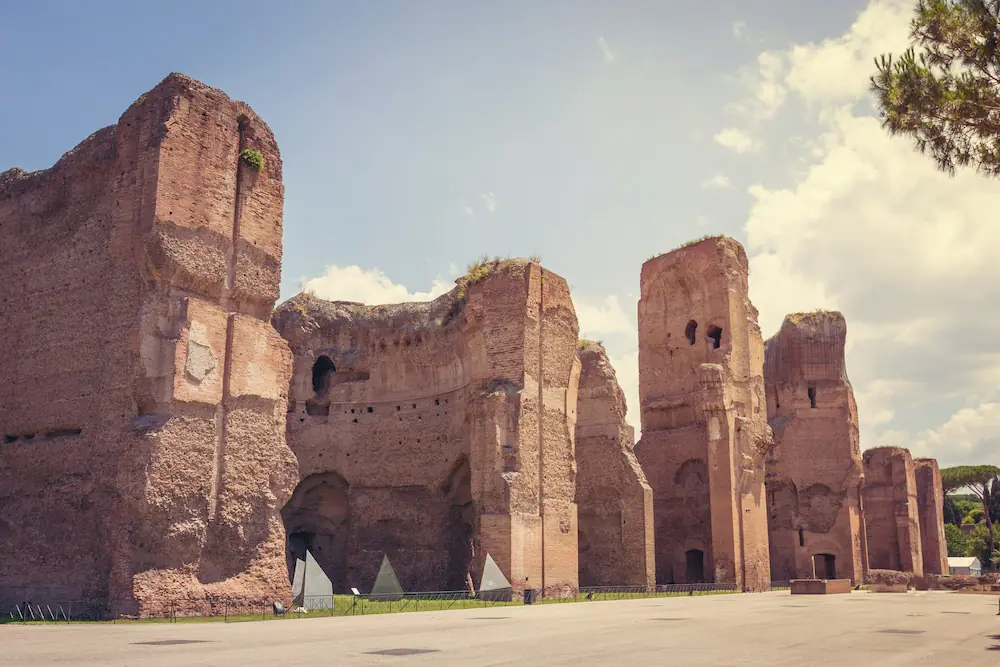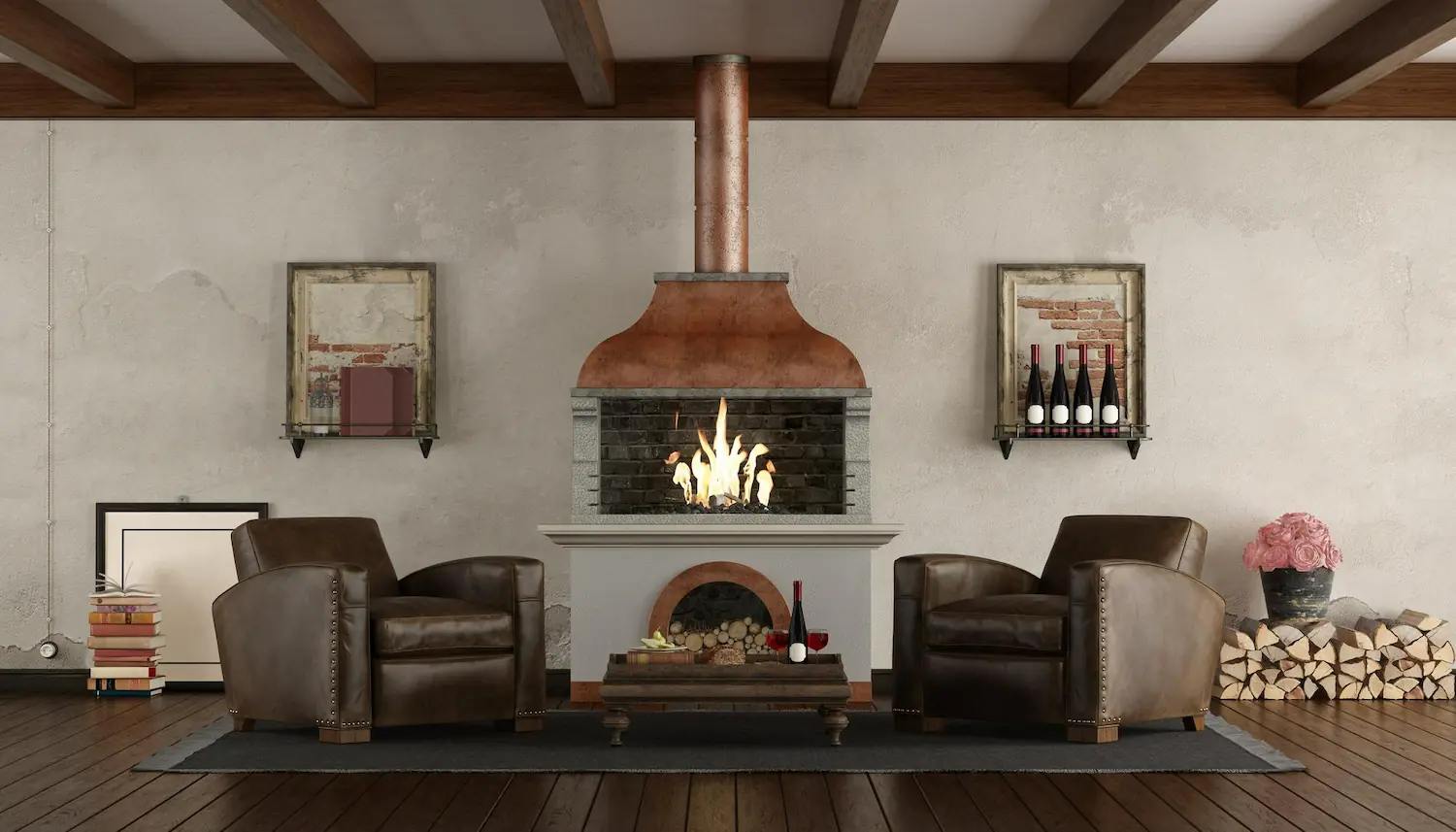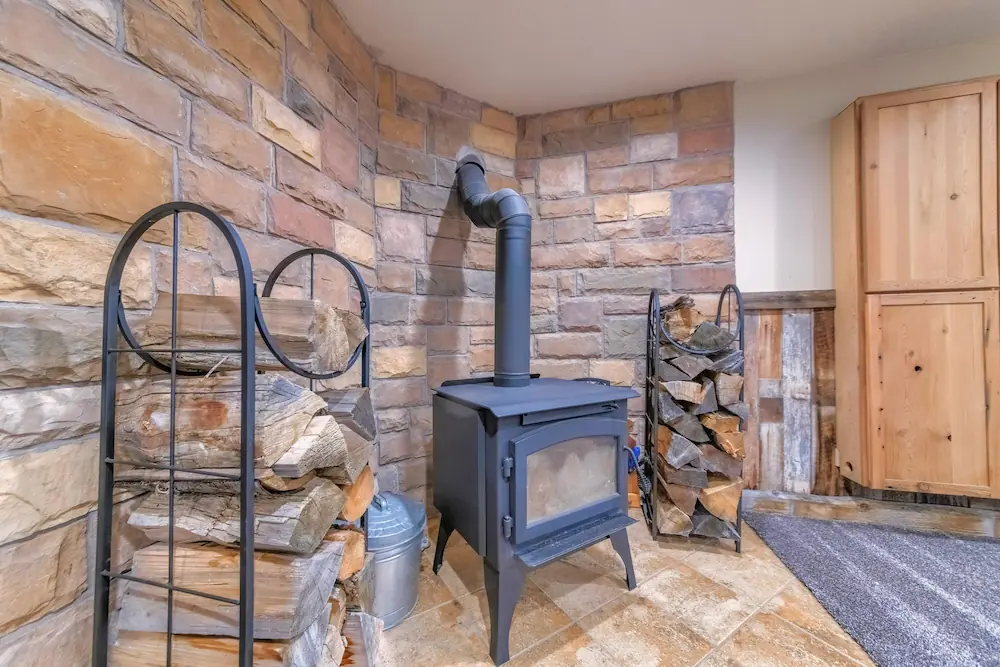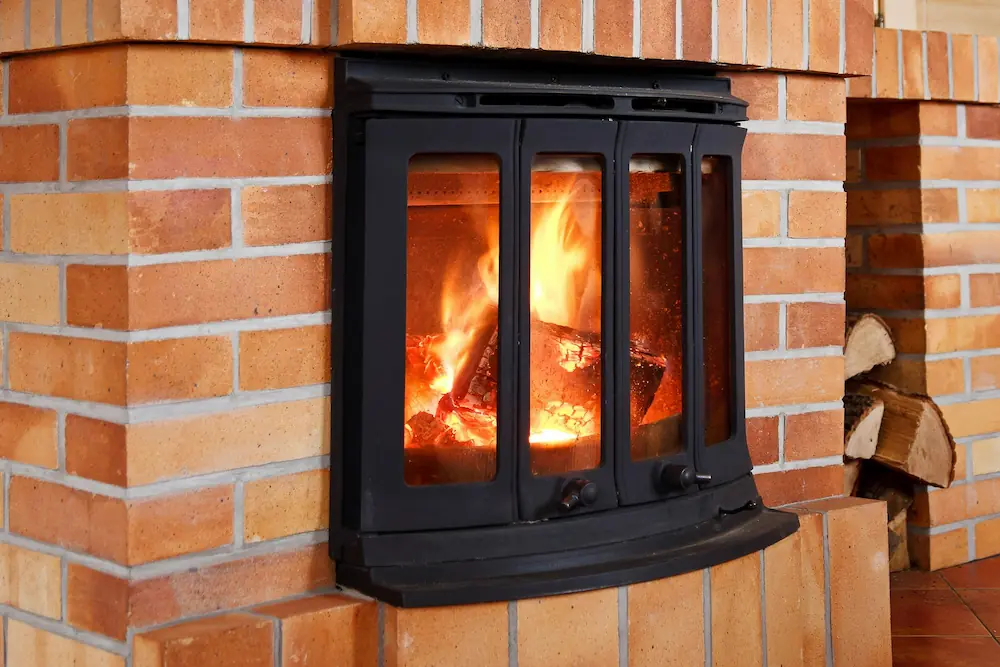Fire has been used as a method of heating for between 1 and 1.5 million years, so the fireplace was only one step in the domestication or control of fire.
However, it took hundreds of thousands of years from the time fires were first built on the ground to the invention of the fireplace as we know it today. In this article we are going to show you the history of the fireplace, who invented it and how it has evolved throughout history.
History of the chimney
The history of the fireplace and its evolution are inevitably linked to the technical innovations and transformations that the home has undergone over the centuries.
Background of the chimney
At the dawn of civilisation, fireplaces as such did not exist. Holes were made in the ground where fires were lit for warmth. In caves and huts, a fire was built in the centre to keep the whole room warm. The risk of fire was very high, as most of the houses were wooden huts.
Gradually, ways were devised to control the fire by securing the area. One of them was the creation of clay ovens in which food was cooked and which allowed the space to be heated. However, smoke was a problem as it spread throughout the house and could intoxicate the occupants.
Attempts at the chimney in ancient Greece
The chimney is a construction solution that appeared relatively late. The Greeks had a word for it, but in practice they did not know it. The closest thing they had to a chimney was a hole in the roof that allowed smoke to escape from the dwelling.
This hole was called a kapnodeia. It was a vent that was opened and closed by means of a valve. However, the most common method of letting out the accumulated smoke was to open the windows, as can be seen in the ancient theatre.
Attempts at chimneys in the Roman Empire
Nor did they have chimneys in the Roman Empire, where they used the word caminus for a chimney-like system. However, their advances in this respect were evident, as they used central heating systems to heat the house and the water they used.
These systems, called hypocaust, were similar to the ovens they used outside the domestic context. They channelled fire and heat through pipes installed under the floor and inside the walls. This heating mechanism, which included a flue, was widely used in forges, furnaces and mines.
This type of heating furnace is the origin of today’s thermo chimneys. They were used to increase the temperature inside the houses, and the smoke was circulated externally. Although it was a great advance in heating, this system was only used in the homes of wealthy families who could afford it.
Therefore, to a certain extent, the Romans did not see the birth of fireplaces, as they had hypocaust systems, which were mainly used in the baths of the Roman Empire. In the following centuries, the system was improved and incorporated into the caldarium (hot rooms) of the baths and the villae, which were the wealthiest private houses.

The absence of fireplaces as we know them was the reason why the most important rooms were located on the southwest side of the houses. It is on this side that there are the most hours of sunshine on winter evenings, which was the time when the main meal took place.
Attempts at chimneys in the Middle Ages
With the fall of the Roman Empire, this innovation was lost and a return was made to earlier, much more dangerous methods, although these had continued to be used in the humblest of houses. The most common heating system consisted of a fire lit on the ground, which generated waste and smoke within the everyday space.
As a result of this practice, a very characteristic feature of Medieval houses was the soot that adhered to the roof beams. Some dwellings had openings in the roof that served as an exhaust for the smoke, but they were not very functional. Even less so on rainy days.
The first chimney in history
The oldest chimney discovered to date dates back to the 1st century and was found in Pompeii. It is a square construction made up of five tubes that converge in a general tube. It is this main pipe that protrudes from the house through the roof.
Origin of the modern chimney
The true origin of the chimney has to do with changes in the structure and height of buildings. When houses with two or more storeys began to be built, a problem arose. It was not possible to light the fire in the middle of the rooms, as it was necessary to extract the smoke and the upper floor prevented the creation of openings for this purpose.
For this reason, they began to build structures attached to the walls in which the fire was lit and the smoke exited through a duct. This was the birth of the chimney as we know it today.
However, with these early designs the smoke exited the room horizontally through the side wall. This ventilation outlet continued to cause problems with the smoke, as it reached and surrounded the upper floors. This type of chimney appeared in the 12th century and was very rudimentary, as it had no jambs or lintel.
Evolution of the chimney
The evolution of fireplaces during the Middle Ages was slow. One of the great advances came in the 13th century with the emergence of circular chimneys with flues built into the walls. These chimneys had a semi-conical bell supported by legs that raised it above the ground.
Fireplaces as part of the hearth decoration
In the 14th century, fireplaces became rectangular and the conical bell became pyramidal. In addition, a cover was added to the back or trashogar as protection so that the wall of the house would remain intact.
This protective cover was made of tiles or cast metal plates. On the outside of the chimney, which faced the interior of the house, protection was provided by a curved lintelled arch made of large stones or voussoirs.

In the Renaissance period, artists took advantage of any space to express their creativity. Fireplaces were no exception and became objects of great decorative value. In this period they were not always attached to the wall.
Instead, they were often placed in the centre of noble rooms as an important aesthetic element. Trophies, noble coats of arms and panoply were often placed on them. They were also decorated with bas-reliefs, especially at the end of the 15th century, when they began to move closer to the walls of the main room.
In England and France, the fireplace was definitively relocated to the walls of noble houses from the 15th century onwards. In particular, they were usually placed in the centre of the longest wall of the main room. The fireplaces in these wealthy houses were usually made of brick or granite.
The popularisation of the chimney
By this time, however, the fireplace was no longer the preserve of the nobility or the bourgeoisie. Its use had spread to the common people and the modest classes, since the tax on having a chimney on the roof had been abolished. For a long time it had been considered a luxury on a par with having balconies or windows.
Later, in the 17th century, another remarkable development took place. The Roman-German prince Rupert da Rin devised a grill-like grate that allowed air to pass under the fuel. As a result, the fire burned longer and the ash was released from the flames.
The cast-iron chimney
It was in the 18th century that Benjamin Franklin invented the cast-iron chimney, which he named after himself. The advantage of this system was that the heat was maintained even after the fire had been extinguished. This was due to the metal’s ability to retain heat energy.

Benjamin Franklin’s cooker totally eliminated the presence of smoke in the home. It was usually placed in the centre of the main room. The advent of this invention reduced the use of fireplaces. However, its power of combustion and heat generation was such that it increased the risk of fire.
The final versions
Subsequently, Count Rumsford redesigned the chimney, increasing its safety and improving the smoke outlets. In this way, chimneys were finally adapted to the walls of houses.
In the 19th century, safer chimneys with more flues were invented, which made chimneys fit into the walls of houses. The Industrial Revolution of the 19th century also had a major impact on the performance of the chimney, as innovations led to the design of smaller fireplaces with safer and stronger materials. The Adam brothers were primarily responsible for these improvements.
By the beginning of the 20th century, fireplaces had become an indispensable feature of the home. At this time, however, the central heating system reappeared and the fireplace ceased to be a primarily pragmatic element and became primarily a decorative element, a symbol of luxury and class.
The chimney today
Nowadays, existing fireplaces fully insulate the fire, which maximises safety in the home. In addition, closed systems make better use of fuel and reduce heat loss. In this way, the heat remains constant. Otherwise, the system has not changed much since the 19th century.

In any case, the fireplace has been relegated to a decorative and romantic role due to the widespread use of central heating, electric cookers and other means of heating and air-conditioning in houses. Although it is still used in villages, it occupies above all a role in folklore and tradition.
History of the chimney in Spain
In Spain, the history of the fireplace began in Castile in the 13th century. Its use spread from the 14th century onwards. From the Renaissance onwards, the fireplace dominated the landscape of towns and villages, especially in Spain, Italy and France. In the 17th and 18th centuries, fireplaces began to be made of marble instead of stone in Spain and France.
Etymology of the word chimney
The origin of the word chimney is in the Greek word káminos, which gave rise to the French word cheminée, and came into Spanish as chimenea. In Spanish, the word chimenea appears at the end of the 14th century. Before that date, the Castilian word used to name the same concept was fumero or humero.




